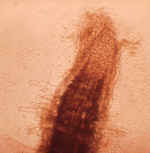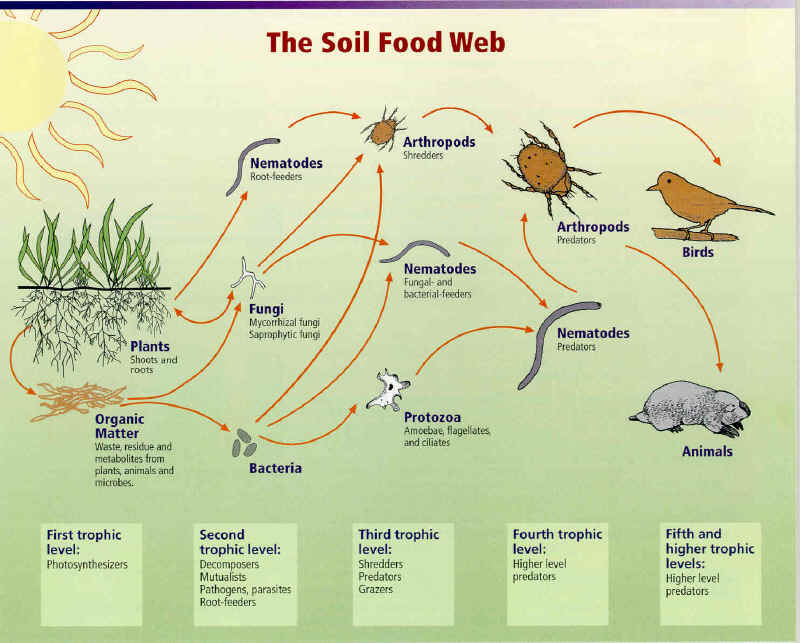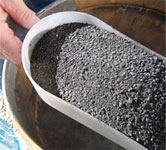The creatures living in the soil are critical to soil quality. They affect soil structure and therefore soil erosion and water availability. They can protect crops from pests and diseases. They are central to decomposition and nutrient cycling and therefore affect plant growth and amounts of pollutants in the environment. [Source: The Soil Biology Primer, Natural Resources Conservation Services, USDA]
Rhizosphere

The rhizosphere is the narrow region of soil that is directly influenced by root secretions and associated soil microorganisms [1]. It is teeming with bacteria that feed on sloughed-off plant cells, termed rhizodeposition, and the proteins and sugars released by roots. The protozoa and nematodes that graze on bacteria are also concentrated near roots. Thus, much of the nutrient cycling and disease suppression needed by plants occurs immediately adjacent to roots. [2]
There are three main areas of research that are done on the rhizosphere. The first one is the “influence of roots on microorganisms.” The second is “influence of microorganisms on plant growth,” and the third is “rhizosphere influence on soil-borne pathogens and plant disease.” (Curl, 1986)
Scientists believe that there is much to learn about this important zone and the nature of the symbiotic relationship of soil flora and fauna to the root systems of plants. [3]
Biochar
The term 'biochar' refers to black carbon formed by the pyrolysis of biomass i.e. by heating biomass in an oxygen-free or low oxygen environment such that it does not (or only partially) combusts.
Traditional charcoal is one example of biochar produced from
wood. The term 'biochar' is much broader than this however, encompassing black
carbon produced from any biomass feedstock.
Biochar benefits
The use of biochar as a soil additive has been proposed as a means to simultaneously mitigate anthropogenic climate change whilst improving agricultural soil fertility.
As a soil amendment, biochar creates a stable soil carbon pool that is carbon-negative, serving as a net withdrawal of atmospheric carbon dioxide.
The enhanced nutrient retention capacity of biochar-amended soil not only reduces the total fertilizer requirements but also the climate and environmental impact of croplands. In greenhouse experiments, soils amended with biochar at high rates have shown 80 percent reductions in nitrous oxide emissions and complete suppression of methane emissions, [4] and reduced runoff of phosphorus into surface waters and leaching of nitrogen into groundwater. [5]
As a soil amendment, biochar significantly increases the efficiency of, and reduces the need for, traditional chemical fertilizers, while greatly enhancing crop yields. Renewable oils and gases co-produced in the pyrolysis process can be used as fuel or fuel feedstocks. Biochar thus offers promise for its soil productivity, energy, and climate benefits.
However, too much of a good thing such as biochar may not be immediately beneficial in nutrient deficient soils, because it will “compete” for nutrients until it is saturated. [6]
The Soil Food Web
The soil food web is comprised of billions of organisms - bacteria, micro-arthropods, fungi, earthworms, insects, plants and animals - interacting at different trophic levels to provide food and energy for the growth and maintenance of this diverse community. They range in size from the tiniest one-celled bacteria, algae, fungi, and protozoa, to the more complex nematodes and micro-arthropods, to the visible earthworms, insects, small vertebrates, and plants.
The soil food web has several components 1) Flora: bacteria, single cell organisms and fungi; and 2) Fauna: nematodes and arthropods, and 3) visible creatures such as earthworms and insects, and even vertebrates like moles and robins.

-------------------------------------------------------------------------------
Here is a link to a group of videos from Iowa State University about soil biology.
-------------------------------------------------------------------------------
Soil Food Web Benefits
As these organisms eat, grow, and move through the soil, they make it possible to have clean water, clean air, healthy plants, and moderated water flow. [2]
There are many ways that the soil food web is an integral part of landscape processes. Soil organisms decompose organic compounds, including manure, plant residue, and pesticides, preventing them from entering water and becoming pollutants. They sequester nitrogen and other nutrients that might otherwise enter groundwater. They fix nitrogen from the atmosphere and they mobilize phosphorus and make them available to plants.
Many organisms enhance soil aggregation and porosity, thus increasing infiltration and reducing runoff. Soil organisms prey on crop pests and are food for aboveground animals.
Carbon entering into this food web comes either directly or indirectly from the plant as plant residues or root exudates, but ultimately from the atmosphere through photosynthesis. The microbes in this food web are also environmental engineers, who manipulate their environment to increase their access to food and support greater growth.
Soil aggregate formation and stabilization is a prime example of microbial engineering. Fungal hyphae arrange primary particles (i.e. sand, silt, and clay) into conglomerations, which are glued together and stabilized by bacterial and fungal metabolites/exudates. These aggregates protect microbes on and within them from predation, loss of habitat, and loss of food or organic matter. Adequate soil aggregation is also necessary for optimum plant health, enhancing drainage and aeration, as well as spaces for root growth. Soil aggregation is extremely important for soil stability as it reduces both wind and water erosion by binding the finer soil particles into the larger aggregates. Additionally, these aggregate-binding products are composed of carbon pulled from the atmosphere, and provide a major carbon sink. [7]
Tillage, pesticides, and high fertility inputs have damaged the environment favorable to microbial growth by mechanically shearing aggregates, exposing buried humus to rapid decomposition and carbon loss to the atmosphere, and reducing root exudates. No-till, diverse cropping systems have demonstrated their ability to rebuild microbial populations and improve soil quality.
Management for a healthier soil food web will enhance microbial engineering, which will benefit soil fertility and reduce risks from diseases and extreme weather patterns, such as drought or flooding.
RhizoChar™ supercharges biochar by inoculating it with
soil food web microorganisms and nutrients.

[1] "Microbial
Health of the Rhizosphere".
http://uwstudentweb.uwyo.edu/T/Twhite/. Retrieved on 2006-05-05.
[2] Ingham, Elaine R., Soil
Biology Primer, USDA-NRCS, 2000 http://soils.usda.gov/sqi/concepts/soil_biology/soil_food_web.html.
[3]
Nichols, Kristine, Soil Microbiologist, Northern Great Plains Research
Laboratory, Mandan, N.D., A.R.S./U.S.D.A, personal communication, 21 January
2009
[4] Rondon et al. 2005, “Biochar sequestration in
Terrestrial Ecosystems,” Mitigation and Adaptation Strategies for Global Change, (2006) 11: 403–427
[5] Biochar carbon-negative fertility, food & fuel, http://terrapreta.bioenergylists.org/files/0-Biochar%20FAQ.pdf
[6] Terra preta, http://en.wikipedia.org/wiki/Terra_preta
[7] Amaranthus, Mike, Jeff Anderson,
Zack Amaranthus, & Dave Perry,
“Building Soil Organic Matter Biologically - The Benefits of Mycorrhizal Seed Inoculation,” Acres/USA, January 2009 • Vol. 40, No. 1,
http://www.acresusa.com/toolbox/reprints/Jan09_Amaranthus_etal.pdf.
[8] “Glomalin,
What Is It . . . and What Does It Do?,” Agricultural Research, July
2008 http://www.ars.usda.gov/is/AR/archive/jul08/glomalin0708.htm
Copyright 2010 The RhizoChar Group, LLC